 Web Site (Concepts)
Web Site (Concepts) |
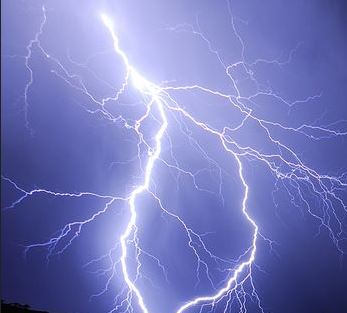 Let There Be Light (space expansion)
Let There Be Light (space expansion)
|
 Eternity -a
practical concept
Eternity -a
practical concept |
Cosmos Dynamics - the creation of the mass, time, space
and energy union
Copyright Allan Webber (BSc, Grad Dip Ed Admin),
2017
In my web pages called Let There Be Light and Propagation Mechanisms I present a case for the photon being part of a realm that has no space, no time and no mass. I justify this by recognizing it as a part of a duality; with its twin being a point in newly created space that keeps the photon in touch with the material world.
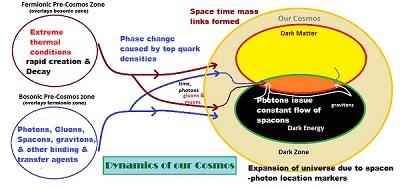
I believe not when the basis of our questions is the observed properties of our universe. So the knowledge that energy is conserved within the known physics of our universe means we can assume that the quantity of energy our universe received had the same value in its pre-existent realm.
Our choices as to the origin of our universe has generally come from three options one of which suggests there was nothing, a second in which our universe is part of a continuum and the third form being that of a change of state within, what our universe would consider, an unobservable chaos.
The first of these options attempts to avoid the question of an even older heritage for our universe's evolution but does so at the cost of denying any link between the previous state and our own. It requires a miracle to make everything happen from nothing.
The second option has some backing in our modern context since the evidence based story of our universe has a close match to the evidence from observations of black holes. In such a scenario our universe is a bubble in a fractal series. Such a series is created from the element that precedes it so it inherits a fraction of the parents' dimensions.
The black hole context offers an explanation to the unobservable parentage; it lies in the expansion of space and the fixed speed of light. The origins of the universe in this model go back beyond the black hole mechanism to the questions surrounding the origin of this sequence.
The continuum theory has a beginning and a limiting threshold since the dimensions shrink with each new generation. However its fundamental question takes us to the same point in evolution as the third option.
Both the second and third options enable us to examine the past and future which benefits our understanding of the present. And from what we have observed so far we do know much about the unobservable realm from which our universe came. We can, for instance, justifiably assume the continuity and conservation laws that are observably apparent in our universe were inherited. Therefore the most basic principles of our own experience can be assumed to be valid examination tools when considering the realm before the genesis of our universe.
|
Premises: The major premises underpinning this Cosmology of our Universe include:
Using these above premises I think it reasonable to believe our universe originated by the union of two zones that didn't have mass, time or space but held either unlinked parts or the components capable of producing them. In so doing it delivered to our universe the properties that it has. It is also reasonable to believe that the elementary particles that make up our universe were located in two separate zones that came together in a manner that initiated the properties we can detect and measure. From this we can also conclude that it is reasonable that one zone was dominant in Fermionic (material type particles) and the other carried components where Bosonic (non-material) qualities were dominant. |
The original forms of the elementary particles seen in our universe are the most probable part of what existed in the parent realm. So it is the properties of these particles and their ability to change the state of their environment that offers the most credible base for reconciling the two realms.
And the most important issue that this base has to reconcile is a realm where space, time, and mass are not linked. We need to identify the elements that can provide at least three important links. Time must be linked with space, mass must be linked with time and mass must have a further independent link with space.
To this end we have an invaluable starting point; we know the universe inherited a quantifiable amount of energy and we have evidence in the inferno's in our own universe that suggests it was in an intense form.
Although we can't answer the question of how it got to exist at all and to have the property of high intensity we can know that it didn't come into being on its own; it had to be associated with a carrier of that energy from the pre-universe and it is the fundamental particles that are still carriers of energy as well as the companion fundamental binding agents providing force and cohesion that will be the focus of this paper
Central to this purpose is going to be the third family of quarks, especially the role of the top quark, the gluons and the 'spacon'.
The latter is a particle I have previously hypothesized (See EMW Space Creation). This new concept offers a good means of understanding the propagation of light and also offers a mechanism for both the observed features of black holes and the expansion of the universe.
The essence of the Primordial Chaos.
Intense energy beyond anything observable in our universe is a logical assumption since from our observations in this universe such sources lay behind the destructive and constructive agencies that have shaped everything in our universe. It is physical, nuclear and chemical events that have the potential to change the settings of an existent extreme-energy environment taking it to trigger points where the old order no longer applies. That same process is a reasonable basis for the primordial chaos since it then provides continuity even though the observable components in the pre-universe state may lie outside direct human observation.
Energy is both the creator and the destroyer of chaos but it also holds the same capacity for establishing and maintaining order in each system. And although Chaos cannot sustain eternal order, packets containing order can emerge where normal infernal interactions cause energy intensity and variability to decline.
In the primordial chaos creation and destruction occur so rapidly that it is difficult to give the label of time to anything. In chaos most things don't endure. There are few sequences and those that come into being are short. The label of time is mainly non-applicable to components of a system where chaos rules. Similarly the label of space of the type we experience has no meaning for it has no continuity in a system in chaos. Yet a variant form of mass can be applied to the carriers that chaos must possess. And time and space can be assigned but not in the forms that characterize our universe.
Within this context I propose that the elementary particles with established mass values are the parental carriers of energy in the pre-universe. Yet due to forces binding the chaos there is no kinetic energy involved; there is only chaotic mass capable of holding the energy of creation and destruction through latent (internal energy) and rotation. Within our universe this prototype energy is seen in both nuclear decay and fusion and in this sense the primordial chaos is reflected in the core of black holes. We can therefore assume with some confidence there is a binding force that holds the chaos in a state in which there is no relevance to questions about linear size or lifespan.
The top quark's properties suggest it is a base carrier for the mass-energy and space. This particle is the heaviest of the mass bearers but it doesn't occur naturally in our universe.
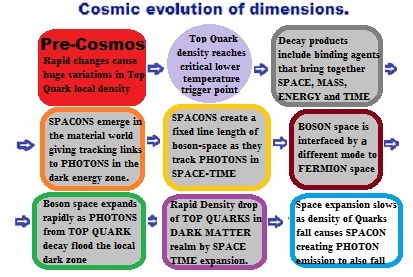 Our initial observations of the top quark are due to machines built by
scientists of the modern era. These produce high energy collisions
between protons and antiprotons that have been accelerated to
extraordinary levels. This process absorbs a great quantity of energy
from the environment for each particle produced.
Our initial observations of the top quark are due to machines built by
scientists of the modern era. These produce high energy collisions
between protons and antiprotons that have been accelerated to
extraordinary levels. This process absorbs a great quantity of energy
from the environment for each particle produced.
The top quark is the most massive of the known elementary particles and has a mass exceeding an atom of gold. But the extraordinary human feat of taking small particles and producing very much larger ones depends on the kinetic speed of the particles being high enough.
As a result of that creation we now know the threshold that triggers the absorption of kinetic energy in the creation of mass. But it only generates a short-lived gain since this particle decays almost immediately into smaller particles. The top quark's life is a finite but very minute time of 5 x 10-25 seconds.
The containment of the energy that leads to quarks is via forces that give that energy boundaries. All these happenings preserve the conservation rules by absorbing energy into several modes of internal spin and other properties such as charge and flavor. The latter is a property unique to elementary particles and was introduced to reconcile observed behavior not seen in the classical world.
Hence through this binding of energy we temporarily have the most massive of known particles confined within an observable space but it lacks the critical element that takes it outside its origins. It is mass-space and not space with nothing in it. Yet the mass-space of the individual particles involved is greater than the compacted mass of the quark. The reminder of that space can only be accounted for by its transformation into matter-free space. This implies there are two classes of space, one associated with matter and another linked to non-matter. And there is critical evidence supporting this division since the expansion of space doesn't affect the size of material objects only that of the void surrounding matter.
When energy transforms into material in which mass can be detected it creates denser matter-space. And in the primordial chaos top quarks are in abundance since there is a plentiful amount of energy above the required threshold. This abundance means it is statistically possible that adjacency will reach a critical level and the frequent massive particle collisions will generate even more of the heavier mass particles. And this in turn lowers the energy density, i.e. temperature, of the zone where this occurs for the energy is now resident as latent energy within the newly formed structure.
It is this the quarks abundance in this infinitely varying environment that provides the trigger point required for the space and mass properties of our universe. However the top quark decay process can't provide a time component. It requires a fortuitous grouping of a supportive set containing all the elements to tie mass, space and time together and when this occurs the top quark plays a critical but self defeating role. The creation event lowers energy density and this implies lower temperature.
Since the top-quark doesn't endure long in either realm its decay then becomes a relevant factor limiting the fore-mentioned enhancement environment. The density of the quarks can quickly fall below the required threshold for creation of new particles and the constant generation needed for their existence ceases. They are no longer in abundance and in this environment the falling temperature stabilizes the environment enough to cause the rapid top-quark renewal to cease.
 The photons within the chaos
are the
likely carriers of energy-space-time
components for our universe. This elementary component is one of several
that has no mass but it is created at the surface of the space occupied
by mass and once created has eternal existence in the primordial chaos
unless it encounters an object in a mass-space form. But the strength of
its parent mass prevents its escape.
The photons within the chaos
are the
likely carriers of energy-space-time
components for our universe. This elementary component is one of several
that has no mass but it is created at the surface of the space occupied
by mass and once created has eternal existence in the primordial chaos
unless it encounters an object in a mass-space form. But the strength of
its parent mass prevents its escape.
The photon within the chaos sits at the boundary of space of the mass like objects from which it is issued. And the photon remains in its mass-defined location even when the mass' fleeting existence has come and gone. It is therefore a component with plenty of time and nowhere to go.
Nothing can happen by the presence of particles alone and it requires binding agents for change to occur. The gluon is also a massless component in the standard model of the elementary particles and is essential for the existence of mass-space within chaos as well as our cosmos. It is the carrying agent of cohesion with properties that differ from those components possessing mass. Yet it is essential for there to even be a concept of mass. And it has cohesive properties that are vastly different from those arising from mass, flavor and charge.
The major difference is its strength increases with distance in an interaction that confines it to tubes. Observations made from experiments using the same generation of machines as led to the identifying of the quarks indicate that quarks and antiquarks don't exist on their own. They either reunite with the quarks bound by the gluon or when the energy exceeds another trigger pointthey generate equivalent combinations of quarks with smaller mass. So the gluons don't occupy space at all; they are bonds whose strength increases with distance.
The ideas expressed in the above passages parallel current ideas for explaining the beginning of our universe. Modern thinking on the early universe sees a new state of matter-energy called a quark-gluon plasma which is thought to occur only at extreme temperatures. And within this state various cohesive forces are lessened. This consistency with ideas presented above arises from common considerations about conditions needed to initiate the union of mass, space, time and energy.
But such an initiation requires more than a trigger point; it needs an evolutionary path; a mechanism of forming something that is stable beyond its current barriers. That mechanism is a process of evolution.
The patterns for evolution come from a hidden zone one of whose contents is the zone of numbers. But this hidden zone holds other associated zones such as patterns generated by the logic of adjacency. Within these non-physical realms lies a path where the duad provides the first step. This is followed by the triad and a logical sequence thereafter.
Despite its non-physicality number offers a reality detected in nature hence it's no surprise to find the standard elementary model is dominated by pairings and triplets. Quarks in pairs form mesons while as triplets they form matter such as protons and neutrons. Elementary particles also have anti-particles which carry the mirror images of their essential properties. And also charge comes in two states while the property called color in particle physics relates to three states akin to another form of charge.
In addition there are three families of quarks plus leptons with two quarks and two leptons in each family. The list could go on but the idea is clear; evolution follows the logic of numbers and its inherent patterns are built on the same primary numbers used in forming the earliest components of the cosmos.
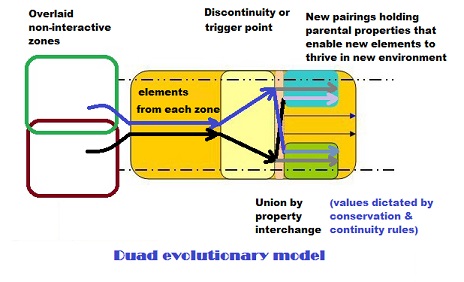 But
the mechanism of evolution has to be able to take pairs beyond the
barriers that confine their normal activity while obeying all the laws
of continuity and conservation. The model for this I believe is the one
shown alongside and its logic can be readily seen in the genetic stream
enabling life.
But
the mechanism of evolution has to be able to take pairs beyond the
barriers that confine their normal activity while obeying all the laws
of continuity and conservation. The model for this I believe is the one
shown alongside and its logic can be readily seen in the genetic stream
enabling life.
The logic of this mechanism also lies in the hidden zones that accompany existence. It is founded in the primary steps of natural numbers mentioned above.
And of these steps adjacency is the singular condition that can induce a change in chaos. So the post-chaos realm begins with links utilizing the number two. It should be noted that adjacency occurs in every spectrum even if that spectrum forms a single ray so this concept isn't necessarily linked to either space or time it is a relationship involving order and location.
However for any greater meaning to emerge from any adjacent state another property, cohesion, is required for which the number two is also the base. Cohesion means adjacency lingers; pairs endure breaking down the monopoly of chaos.
And number flows from there, firstly through continuity and creation of sequence and then through geometry and natural patterns.
The natural place of this and other hidden zones is important in the dynamics of the cosmos since the mechanics of the universe relies on them. But many properties lack the dimensions of common life so they are often overlooked.
The evolution mechanism given above, based as it is in the most elementary principles of number, reproduces the idea of adjacency, cohesion, continuity, sequence and creation of novel natural patterns.
The creation of the Cosmic major dimensions.
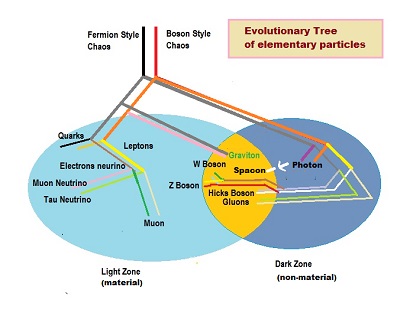 With these components available within chaos evolution can
and will proceed.
And inevitably such a process draws on the components from two zones,
each of which is hidden from the other.
With these components available within chaos evolution can
and will proceed.
And inevitably such a process draws on the components from two zones,
each of which is hidden from the other.
The elementary particles and their antiparticles illustrate this condition. When antiparticles are produced in our universe and meet their counterpart both are annihilated in a burst of energetic glory. The particles dominate our universe and the ideas of conservation imply there is a hidden zone dominated by antiparticles with both isolated from the other. It is therefore possible that the dark matter identified by modern scientists is the realm where antiparticles thrive.
So hidden zones are not unknown to us whether they be conception based or counterparts to the dualities found in our universe.
The hidden zone giving photon's their enigmatic properties.
And the enigmas of the photon imply that its permanent realm is the hidden zone. Photons originate from the surface of matter-based objects and from that instant on are hidden until they interact with another matter based object. They have a fixed maximum speed which applies only to the space unoccupied by matter and it can't be altered by the speed of the matter based objects that define its start and end. The expansion of space only occurs in the type of space through which the trail of a photon passes. These are some of the enigmas and I believe by identifying their residence in the hidden realm and introducing the concept of a spacon linking it to its place in the physical world its enigmatic properties are explicable.
The critical role of the Spacon.
The spacon is somewhat equivalent to a gluon but applies to time and space. The photon in the hidden zone at the time of its initiation from matter produces a spacon with vector properties of direction and a fixed speed. The directional property is the perpendicular at the central point of the hemispherical surface from which it is issued. This spacon is the time-space marker for the photon at that instant of time and space and adda a new point to the existing non-material space. And it implants space points into the material universe at a constant pace; one with which we are nowadays familiar. In every second it creates a vector string of space-points equal in length to the distance light travels.
The photon endures until it re-encounters matter and in every instant of that period (as measured by the photon's creation of spacons) it offers a new spacon enabling propagation to occur while keeping a link to the photon located in the dark zone. So space is affected by this mechanism; it expands as every photon still in passage adds a point to existing space.
The spacon leaves a trail of new spatial points in our universe and from the perspective of the photon in the hidden zone the duration between each point is constant. However for an inhabitant of our universe the light travelling between two points in space must also travel through the expanded distance being created by other photons. In the hidden zone the photon's duration can be equated with a constant rate of spacon creation but in the material part of the cosmos its passage involves both space and time. This is the basis of the relativity connection established by Einstein.
And the spacon can't affect the space occupied by matter because it only exists between two places where mass is absent. Since mass-space is not expanded by the spacon then space too has a dual character fermionic or bosonic in origin and nature. the lack of earlier recognition of the spacon is easily understood since the spacon is the addition of a point that is a void; it is a non-elephant in the room we call the universe.
The reality of the spacon is and has been there for all of us to observe. It must be seen as a void, an ever-growing void that seems to have grown from nothing. Surely this is a most remarkable component of the universe. Yet it is not alone for modern science has observed other peculiar and enigmatic events.
There is a little understood phenomenon called quantum entanglement whose mystery supports the mechanism between the photon and spacon. The entanglement involves particle pairs whose interaction over great distances doesn't fit to our current understanding of space and time. But it might well be explained by a marker system located in the same hidden zone that the photon appears to occupy.
The real importance of the spacon is it brings the concept of space into being; it is the provider of space itself as well as the link to the photon's place in space-time.
This last component is one of the missing links in our understanding of the evolution of our cosmos. With it in place we have the ability to recognize that mass, space and time are not eternal concepts but ones whose birth brought our universe into being in the form we know it.
But of course, as central as the top quark, gluons, photons and spacons are, they aren't the only contributors to our realm. There are other particles and together they unify in the one instant we call the big bang, the relationships of charge and spin to mass, space and time.
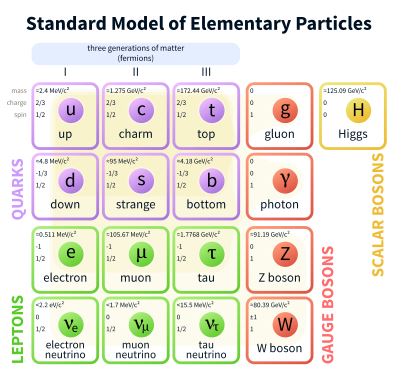
These characteristics magnify the importance of the lighter mass pair, the up and down quarks. The latter two exist in our daily world not just as decay products in the rarefied realm of high energy particle collisions but as stable every day particle. And they are abundant since all neutrons and protons comprise up and down quarks plus binding agents. But their abundance and stability are an outcome of the temperature stabilizing impact of the spacons.
It is apparent that the transition initiated by the drop in temperature via a fortuitous increase in the abundance of the short-lived top quark was the trigger for the creation of our universe. It was this that liberated the space-creating spacon which in turn saw the local impacts on the legacy from chaos grow less disordered. In this density-lowering setting the neutrons and protons could survive but not without help from other legacy components that also thrived.
The electron was one such component. In the modern day we are familiar with this term but its impacts have been on display since the beginning of time. Lightning is the most prominent visible event that is based on the properties of the electron. This is an instantaneous startling intrusion that many animal species have observed since their evolution began. But the atoms that form the base of the material universe also relied on electrons from the universe's Big Bang; long before living things became aware of either atoms or electrons.
Within the standard model the electrons are associated with other elementary particles called leptons. This class differs from the quarks in the nature of their binding forces with the quarks having a very-strong short range force capable of binding them into a cluster whereas the leptons are solitary agents whose binds to other matter depend on weaker distance-dependent forces that can be more easily escaped.
We know the electron is an essential component of atoms and its relationship to the nucleus is via the nature of the opposite charge associated with both protons and electrons. But the charge on a proton comes not from one quark but a collection of three which is the reason why the standard model shows fractional amounts of charge.
The above account suggests a dynamic method possibly leading to the space, time and mass dimensions of the universe we observe. This model implies that these properties may not exist before our universe began while at the same time recognizing the probability of pre-existent factors within a pre-space environment leading to the universe's creation.
But all processes of any complexity have major and minor players and while those discussed above cover the most essential requirements they couldn't achieve the task alone. There is always a fine and beautiful balance between timing and pattern for evolution to occur. And the evidence we have that there was such a balance is that we are here as existent as this equally improbable universe.
END OF PAGE - CLICK HERE for home page